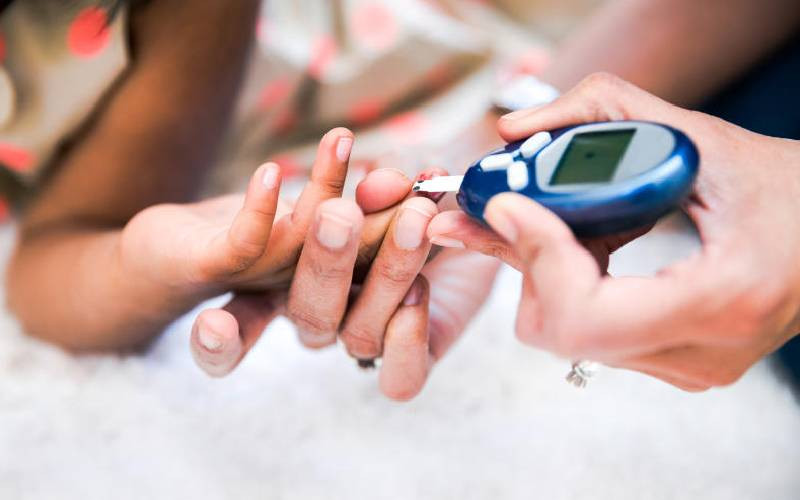
Women can now carry out cervical cancer samples using Evalyn Brush, a self-collection tool, thus skirting embarrassment, discomfort and lack of time which were major challenges in cervical cancer screening.
Dr Charles Wahome, a pathologist at Lancet Laboratories, says Evalyn-brush can be used from the comfort of one's home and "does not cause any discomfort like the speculum and a woman can collect the sample when she gets time from her busy schedule at the health facility with the help of a medic."
Evalyn Brush was approved by the Federal Drug Agency (FDA) in 2014 and has been used in some Western countries and is being introduced in Kenya as an alternative method of sample collection to improve the number of women going for cervical cancer screening.
Dr Wahome explains that the brush has soft bristles to collect the sample when inserted inside the woman's vagina.
"The 18-centimetre-long brush has a plastic plunger which she will use to insert the brush, has two wings which will limit how far the brush can go and then turn the brush five times with each turn making a click sound to indicate that it has made a full turn," he explains. "The woman will them pull the plunger out and replace the cap on the brush, safely keeping the sample clean and out pf contamination."
Washing hands and avoiding to touch the bristles on the brush before and after collecting the sample are key. The brush should be taken to the lab within 48 hours after collection, although if kept at room temperature, the sample will still be viable a week later.
Dr Wahome says there is no risk of losing the sample as there are no fluids involved in the collection hence no risk of spillage, besides the easy-to-use tool kit.

At the lab, the sample is subjected to screening using the HPV PCR testing kit which is 95 percent more effective compared to 60 percent of the PAP smear test.
- Cancer patient's ordeal reveals cracks in healthcare system
- How a burst brain tumor changed DJ Muller's life forever
- Stage 4 cancer but still standing strong: Eunice Mwende's life after terminal diagnosis
- Cancer took my health, heartbreak everything else: Leah Wanjiru's silent battle
Keep Reading
Other widely used methods in cervical cancer screening include a cytology PAP smear and visual inspection where cytology is not available.
According to the World Health Organization (WHO), there are three pillars of eliminating cervical cancer by 2050: HPV vaccination, screening, treatment and management.
Dr Vincent Oyiengo, a gynaecological oncologist at Kenyatta University Teaching, Research and Referral Hospital (KUTRR), cervical cancer which is caused by Human Papilloma Virus and mainly transmitted through infected body fluids through sexual contact, can be prevented using the HPV vaccine.
Dr Oyiengo explains that 90 percent of the eligible girls should be vaccinated before 15 years, the pre-exposure age, and the vaccine will be more efficient if given to the non-exposed girls.
Those above15 can be vaccinated although it may not be as efficient as before exposure to the HPV virus.
Dr Oyiengo says "at least 80 percent of women who are sexually active will be exposed to HPV by the age of 50 years but HPV is transient as the body's immunity can fight it off, so only the bad HPV which is persistent is going to cause the pre-cancerous lesions and eventually lead to cancer."
One major sign of cervical cancer is post-coital bleeding which is the bleeding after sexual activity and a foul-smelling discharge, although according to medics, there are other sexually transmitted diseases that can cause a smelly discharge.
Dr Oyiengo lists unprotected sex, multiple sexual partners and a partner with multiple partners, teen motherhood, age and siring many children as risk factors for HPV transmission.
Non-HPV factors that may cause cervical cancer include smoking and use of oral contraceptives.
"When a patient present with those symptoms, a doctor gets a biopsy, small piece of tissue from the cervix which is taken to the lab where the pathologists ascertain whether there are any cancerous cells," he explains, adding that the HPV test ensures that those who are positive and at risk can be identified early and treated before they progress to cervical cancer.
 The Standard Group Plc is a multi-media organization with investments in media
platforms spanning newspaper print
operations, television, radio broadcasting, digital and online services. The
Standard Group is recognized as a
leading multi-media house in Kenya with a key influence in matters of national
and international interest.
The Standard Group Plc is a multi-media organization with investments in media
platforms spanning newspaper print
operations, television, radio broadcasting, digital and online services. The
Standard Group is recognized as a
leading multi-media house in Kenya with a key influence in matters of national
and international interest.











